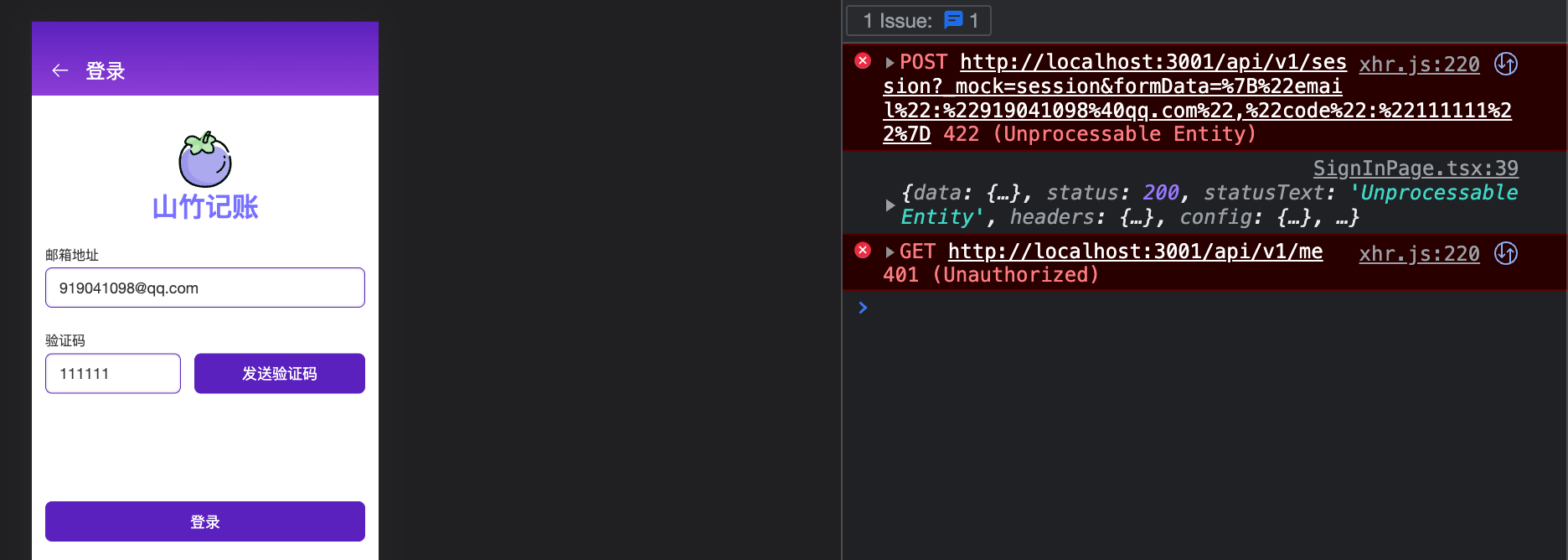自制纯前端Mock系统
手动封装一个Mock
前端项目切换端口:pnpm run dev --port=3001
安装@faker-js/faker:pnpm install --save-dev @faker-js/faker,用于构造假数据。
重构Http.tsx文件,并将JSONValue的定义添加至env.d.ts,将所有请求类型的config都类型都写在了外面。并设计了一个mock函数,如果是线上地址、本地地址就使用mock的内容,且在请求的时候带上了_mock参数,用于区分是那个接口的内容。
tsx
import axios, { AxiosError, AxiosInstance, AxiosRequestConfig, AxiosResponse } from "axios";
import { mockSession } from "../mock/mock";
type GetConfig = Omit<AxiosRequestConfig, 'url' | 'params' | 'method'>
type PostConfig = Omit<AxiosRequestConfig, 'url' |'data' | 'method'>
type PatchConfig = Omit<AxiosRequestConfig, 'url' | 'data'>
type DeleteConfig = Omit<AxiosRequestConfig, 'params'>
export class Http {
instance: AxiosInstance
constructor(baseURL: string) {
this.instance = axios.create({ baseURL })
}
// read
get<R = unknown>(url: string, query?: Record<string, string>, config?: GetConfig) {
return this.instance.request<R>({ ...config, url: url, params: query, method: 'get' })
}
// create
post<R = unknown>(url: string, data?: Record<string, JSONValue>, config?: PostConfig) {
return this.instance.request<R>({ ...config, url: url, data, method: 'post' })
}
// update
patch<R = unknown>(url: string, data?: Record<string, JSONValue>, config?: PatchConfig) {
return this.instance.request<R>({ ...config, url: url, data, method: 'patch' })
}
// destroy
delete<R = unknown>(url: string, query?: Record<string, JSONValue>, config?: DeleteConfig) {
return this.instance.request<R>({ ...config, url: url, params: query, method: 'delete' })
}
// CRUD
// create, read, update, delete
}
const mock = (response: AxiosResponse) => {
// 还可以把线上地址先上去
if (location.hostname !== 'localhost'
&& location.hostname !== '127.0.0.1'
) { return false }
debugger
switch (response.config?.params?._mock) {
case 'session':
[response.status, response.data] = mockSession(response.config)
return true
}
return false
}
export const http = new Http('api/v1')
http.instance.interceptors.request.use(config => {
const jwt = localStorage.getItem('jwt')
if (jwt) {
config.headers!.Authorization = `Bearer ${jwt}`
}
return config
})
http.instance.interceptors.response.use((response)=> {
mock(response)
return response
}, (error) => {
if (mock(error.response)) {
return error.response
} else {
throw error
}
})
http.instance.interceptors.response.use(
response => response,
error => {
if(error.response) {
const axiosError = error as AxiosError
if(axiosError.response?.status === 429) {
alert('你太频繁了')
}
}
throw error
})session的Mock返回内容
tsx
import { faker } from '@faker-js/faker'
import { AxiosRequestConfig } from 'axios';
type Mock = (config: AxiosRequestConfig) => [number, any]
faker.setLocale('zh_CN');
export const mockSession: Mock = (config) =>{
return [200, {
jwt: faker.random.word()
}]
}修改sign_in页面的登录提交的接口内容,带上_mock的内容。
tsx
const onSubmit = async (e: Event) => {
e.preventDefault()
Object.assign(errors, {
email: [], code: []
})
Object.assign(errors, validate(formData, [
{ key: 'email', type: 'required', message: '必填' },
{ key: 'email', type: 'pattern', regex: /^\w+@[a-z0-9]+\.[a-z]{2,4}$/, message: '必须是邮箱地址' },
{ key: 'code', type: 'required', message: '必填' },
{ key: 'code', type: 'pattern' , regex: /^\d{6}$/, message: '必须是六位数字'}
]))
if(!hasError(errors)){
const response = await http.post<{ jwt: string }>('/session',formData,{
params: { _mock: 'session' }
}).catch(onError)
console.log(response)
localStorage.setItem('jwt', response.data.jwt)
// 两种写法
// 1. 跳转的时候拿到存在localStorage的returnTo用于跳转
// const returnTo = localStorage.getItem('returnTo')
// 2. 拿去路由内的参数用于return_to跳转
// 只需要其他地方使用 router.push('/sign_in?return_to='+ encodeURIComponent(route.fullPath))
const returnTo = route.query.return_to?.toString()
refreshMe()
router.push(returnTo || '/')
}
}然后在sign_in页面随便输入验证码然后登录,可以发现实际请求的接口返回的状态码是422,但是使用mock函数返回自己模拟的参数。

完成Tag列表Mock
全局声明Tag类型
在env.d.ts内声明Tag的类型。
tsx
/// <reference types="vite/client" />
declare module '*.vue' {
import type { DefineComponent } from 'vue'
// eslint-disable-next-line @typescript-eslint/no-explicit-any, @typescript-eslint/ban-types
const component: DefineComponent<{}, {}, any>
export default component
}
type JSONValue = string | number | null | boolean | JSONValue[] | Record<string, JSONValue>;
type Tag = {
id: number,
user_id: number,
name: string,
sign: string,
kind: expenses | income
}创建mockTagIndex的mock接口
tsx
import { faker } from '@faker-js/faker'
import { AxiosRequestConfig } from 'axios';
type Mock = (config: AxiosRequestConfig) => [number, any]
faker.setLocale('zh_CN');
export const mockTagIndex: Mock = (config) => {
let id = 0
const createId = () => {
id += 1
return id
}
const createTag = (n = 1, attrs?: any) =>
Array.from({ length: n }).map(() => ({
id: createId(),
name: faker.lorem.word(),
sign: faker.internet.emoji(),
kind: config.params.kind,
...attrs
}))
if (config.params.kind === 'expenses') {
return [200, { resources: createTag(7) }]
} else {
return [200, { resources: createTag(20) }]
}
}修改http.tsx
修改http.tsx的根据_mock的键值返回tagIndex的返回值。
tsx
const mock = (response: AxiosResponse) => {
// 还可以把线上地址先上去
if (location.hostname !== 'localhost'
&& location.hostname !== '127.0.0.1'
) { return false }
switch (response.config?.params?._mock) {
case 'tagIndex':
[response.status, response.data] = mockTagIndex(response.config)
console.log(response)
return true
case 'session':
[response.status, response.data] = mockSession(response.config)
return true
}
return false
}页面调试
在ItemCreate页面,初始化的时候调用获取Tag列表的接口。
tsx
import { defineComponent, onMounted, PropType, ref } from 'vue'
import { MainLayout } from '../../layouts/MainLayout'
import { http } from '../../shared/Http'
import { Icon } from '../../shared/Icon'
import { Tab, Tabs } from '../../shared/Tabs'
import { InputPad } from './InputPad'
import s from './ItemCreate.module.scss'
export const itemCreate = defineComponent({
props: {},
setup: (props, context) => {
const refKind = ref('支出')
const refExpensesTags = ref<Tag[]>([])
const refIncomeTags = ref<Tag[]>([])
onMounted(async () => {
const response = await http.get<{ resources: Tag[] }>('/tags', {
kind: 'expenses',
_mock: 'tagIndex'
})
refExpensesTags.value = response.data.resources
})
onMounted(async () => {
const response = await http.get<{ resources: Tag[] }>('/tags', {
kind: 'income',
_mock: 'tagIndex'
})
refIncomeTags.value = response.data.resources
})
return () => (
<MainLayout>{{
title: () => '记一笔',
icon: () => <Icon name='left' class={s.navIcon}/>,
default: () => <>
<div class={s.wrapper}>
{/* <Tabs selected={refKind.value} onUpdateSelected={name => refKind.value = name }> */}
<Tabs v-model:selected={refKind.value} class={s.tabs}>
<Tab name="支出" class={s.tags_wrapper}>
<div class={s.tag}>
<div class={s.sign}>
<Icon name="add" class={s.createTag} />
</div>
<div class={s.name}>
新增
</div>
</div>
{refExpensesTags.value.map(tag =>
<div class={[s.tag, s.selected]}>
<div class={s.sign}>
{tag.sign}
</div>
<div class={s.name}>
{tag.name}
</div>
</div>
)}
</Tab>
<Tab name="收入" class={s.tags_wrapper}>
<div class={s.tag}>
<div class={s.sign}>
<Icon name="add" class={s.createTag} />
</div>
<div class={s.name}>
新增
</div>
</div>
{refIncomeTags.value.map(tag =>
<div class={[s.tag, s.selected]}>
<div class={s.sign}>
{tag.sign}
</div>
<div class={s.name}>
{tag.name}
</div>
</div>
)}
</Tab>
</Tabs>
<div class={s.inputPad_wrapper}>
<InputPad />
</div>
</div>
</>
}}</MainLayout>
)
}
})详细代码参考可见链接。